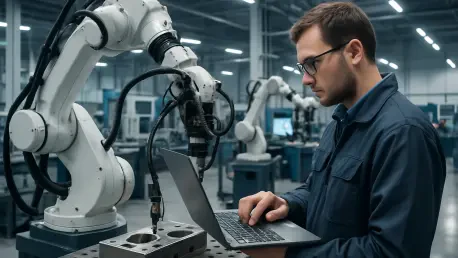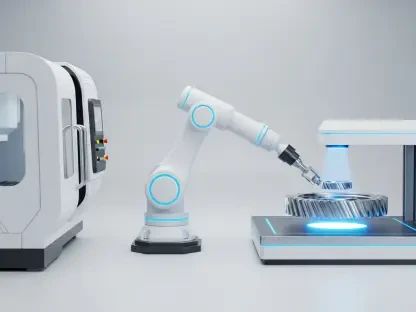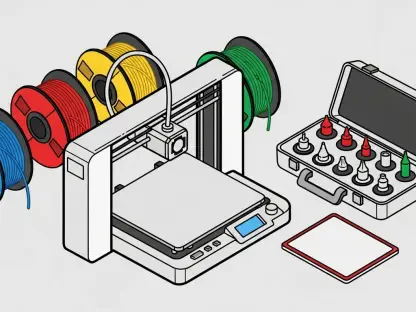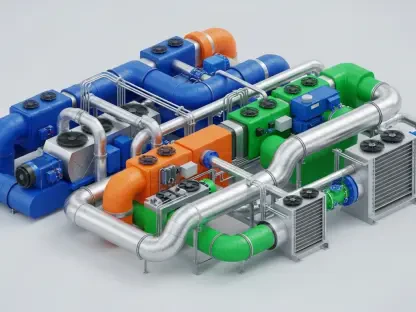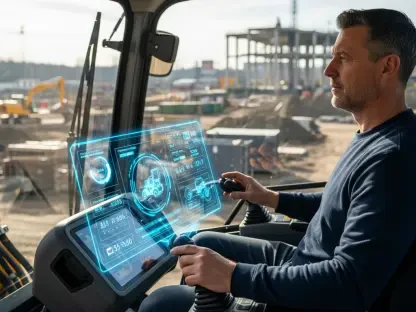The landscape of global manufacturing is undergoing a remarkable transformation with the surge in digital manufacturing, revealing a promising future of efficient and sustainable production methodologies. Valued at USD 117.22 billion in 2023, the digital manufacturing market is projected to catapult to USD 320.0 billion by 2032, representing a robust compound annual growth rate (CAGR) of 11.81% over the next several years. This dynamic upward trajectory underscores industries’ strategic pivot towards embedding advanced technologies to redefine traditional manufacturing frameworks. The integration of features like Artificial Intelligence (AI), the Internet of Things (IoT), robotics, and digital twins is pivotal in crafting intelligent and adaptive production ecosystems, fostering an environment where data-driven decisions optimize every facet of manufacturing processes.
The Technological Backbone of Digital Manufacturing
Integration of Advanced Technologies
In the realm of digital manufacturing, technology integration is a cornerstone that empowers industries to streamline operations and enhance innovation cycles. The incorporation of advanced technologies, particularly AI and IoT, allows for the creation of interconnected systems that facilitate real-time data-driven decisions. These decisions enable the optimization of supply chains and foster an innovative approach to product development. AI helps in preemptive maintenance, quality assurance, and streamlined operations by predicting potential issues and allowing for proactive resolutions. Concurrently, IoT networks link every stage of production, ensuring comprehensive data collection and analysis, thus contributing significantly to operational efficiency and a reduction in production time.
The role of digital twins in digital manufacturing cannot be understated. These virtual models replicate physical assets, processes, and systems, allowing manufacturers to simulate and analyze performance under different scenarios. This capability helps to optimize production processes and identify potential improvements, significantly reducing time-to-market. Moreover, robotics fused with AI enhances automation, ensuring precision and adaptability in manufacturing tasks. This synergy of technologies not only streamlines processes but also enables a shift towards more flexible and responsive manufacturing environments, paving the way for futuristic production landscapes.
Enhancements Through Technological Advancements
Technological advancements within the digital manufacturing domain have propelled the development of increasingly sophisticated processes that redefine production paradigms. Machine learning and edge computing facilitate the rapid analysis and processing of vast data amounts at the source, reducing the dependence on centralized data centers, and thereby increasing speed and efficiency. As 5G connectivity becomes widespread, it supports the seamless interaction of devices and systems, ensuring real-time communication and increasing the potential for remote operations and management. Cloud platforms further enhance this landscape by offering scalable solutions that foster data storage, processing, and sharing across global networks.
Moreover, the integration of Information Technology (IT) with Operational Technology (OT) bridges the gap between traditional manufacturing processes and modern digital solutions. This convergence enables a seamless data flow across various platforms, enhancing coordination and laying the groundwork for establishing an intelligent manufacturing ecosystem. Additive manufacturing, also known as 3D printing, is transforming the production of complex parts with precision and speed, thus enhancing customization and reducing waste. These technological advancements are not merely augmenting the existing processes but are fundamentally reshaping how products are manufactured, setting the stage for an innovative industrial future.
The Global Landscape of Digital Manufacturing
Regional Advancements and Growth
The digital manufacturing landscape varies significantly across different geographic regions, each exhibiting unique growth patterns and technological adoption rates. North America stands at the forefront, driven by its robust industrial automation framework and substantial investments in research and development. Government initiatives support this growth by advocating for smart manufacturing practices, which encourage the integration of digital technologies across traditional manufacturing processes. The emphasis on innovation and competitiveness characterizes the region’s approach, making it a pivotal player in driving technological adoption on a global scale.
Europe follows as a significant contributor to digital manufacturing, particularly in industries such as automotive, aerospace, and high-precision engineering. The region’s focus on sustainability and high-quality standards propels the widespread adoption of digital manufacturing technologies, fostering an environment conducive to innovation. Simultaneously, the Asia-Pacific region is experiencing rapid industrialization and digital transformation, with countries like China, Japan, South Korea, and India making substantial strides in digital manufacturing. This growth is fueled by the region’s focus on improving industrial efficiency and competing in global supply chains, marking it as a burgeoning hub of manufacturing innovation.
Emerging Markets and Their Potential
Emerging markets in regions such as Latin America, the Middle East, and Africa are increasingly exploring digital manufacturing to modernize their production facilities and enhance competitiveness. These areas are gradually adopting digital technologies, facilitated by government incentives and foreign investments aimed at improving industrial infrastructure. While the adoption rates may vary, the potential for growth is significant as these markets aim to overcome traditional hurdles and integrate digital solutions that align with global manufacturing standards.
In regions like Latin America, digital manufacturing is seen as a means to boost economic competitiveness by modernizing production processes and expanding into new markets. The Middle East focuses on leveraging digital manufacturing for diversifying economies beyond oil dependency, while African nations view it as an opportunity to spur industrialization and increase participation in global supply chains. As these emerging markets continue to embrace digital manufacturing, they contribute to the overall growth of the sector, fostering a more inclusive and globally interconnected manufacturing landscape.
Competitive Dynamics and Future Trends
Opportunities and Challenges in the Competitive Landscape
The competitive landscape of the digital manufacturing market is defined by rapid innovation and fierce competition among industry players striving to enhance their technological offerings. Key companies such as Siemens AG, Dassault Systèmes, Autodesk Inc., and PTC Inc. are leading the charge by investing heavily in AI-enabled platforms and smart factory solutions. These efforts are directed towards creating interconnected ecosystems that bridge the gap between design, production, and customer engagement. The focus on platform interoperability and simulation accuracy aims to cater to both large enterprises and mid-market manufacturers, thereby broadening the scope of digital manufacturing applications.
Despite the myriad of opportunities, companies in the digital manufacturing sphere face several challenges. Primarily, the need for a skilled workforce capable of handling complex digital systems is critical. Additionally, ensuring cybersecurity in an era of interconnected devices presents substantial risks that companies must mitigate. The ever-evolving technological landscape necessitates continuous adaptation and innovation, requiring firms to be agile and responsive to market changes. Companies that can successfully navigate these challenges stand to gain a competitive advantage, positioning themselves as leaders in the digital manufacturing revolution.
Anticipated Trends and Innovations
Looking ahead, several key trends are set to shape the future trajectory of the digital manufacturing industry. One significant development is the emergence of autonomous production systems, where AI-driven supply chain optimizations and sustainable manufacturing play crucial roles. Hyperautomation, involving the use of advanced technologies such as AI and machine learning to automate complex processes, and decentralized production are poised to become standard practices. This evolution is further fueled by the increased use of digital twins for factory-level simulation, enabling more precise and efficient production planning and execution.
Furthermore, blockchain technology is anticipated to gain prominence for enhancing traceability and cybersecurity across manufacturing processes. Industry-specific digital manufacturing platforms tailored for sectors such as healthcare devices, aerospace parts, and electric vehicles are expected to rise in demand, offering customized solutions that address unique industry needs. As the industry continues its digital maturation, the synergy between human workers and intelligent machines will likely redefine production excellence, emphasizing collaboration rather than mere automation. These trends signify a transformative era for digital manufacturing, characterized by enhanced capabilities and continuous innovation.
Navigating the Future of Digital Manufacturing
In digital manufacturing, technology integration forms the backbone of industry advancements, empowering operations and driving innovation. Incorporating advanced technologies like AI and IoT creates interconnected systems that facilitate real-time, data-driven decisions, optimizing supply chains and fostering innovative product development. AI aids in preemptive maintenance, quality assurance, and streamlined operations by predicting and resolving issues proactively. Meanwhile, IoT links production stages, ensuring exhaustive data collection and analysis, contributing significantly to efficiency and reducing production time.
Digital twins play a vital role in digital manufacturing by replicating physical assets, processes, and systems, allowing manufacturers to simulate and analyze performance. This helps optimize production, identify improvements, and shorten time-to-market. Additionally, robotics enhanced by AI bolsters automation, ensuring precision and adaptability in tasks. The fusion of these technologies streamlines processes and enables more responsive manufacturing environments, paving the way for cutting-edge production landscapes that are both flexible and innovative.
